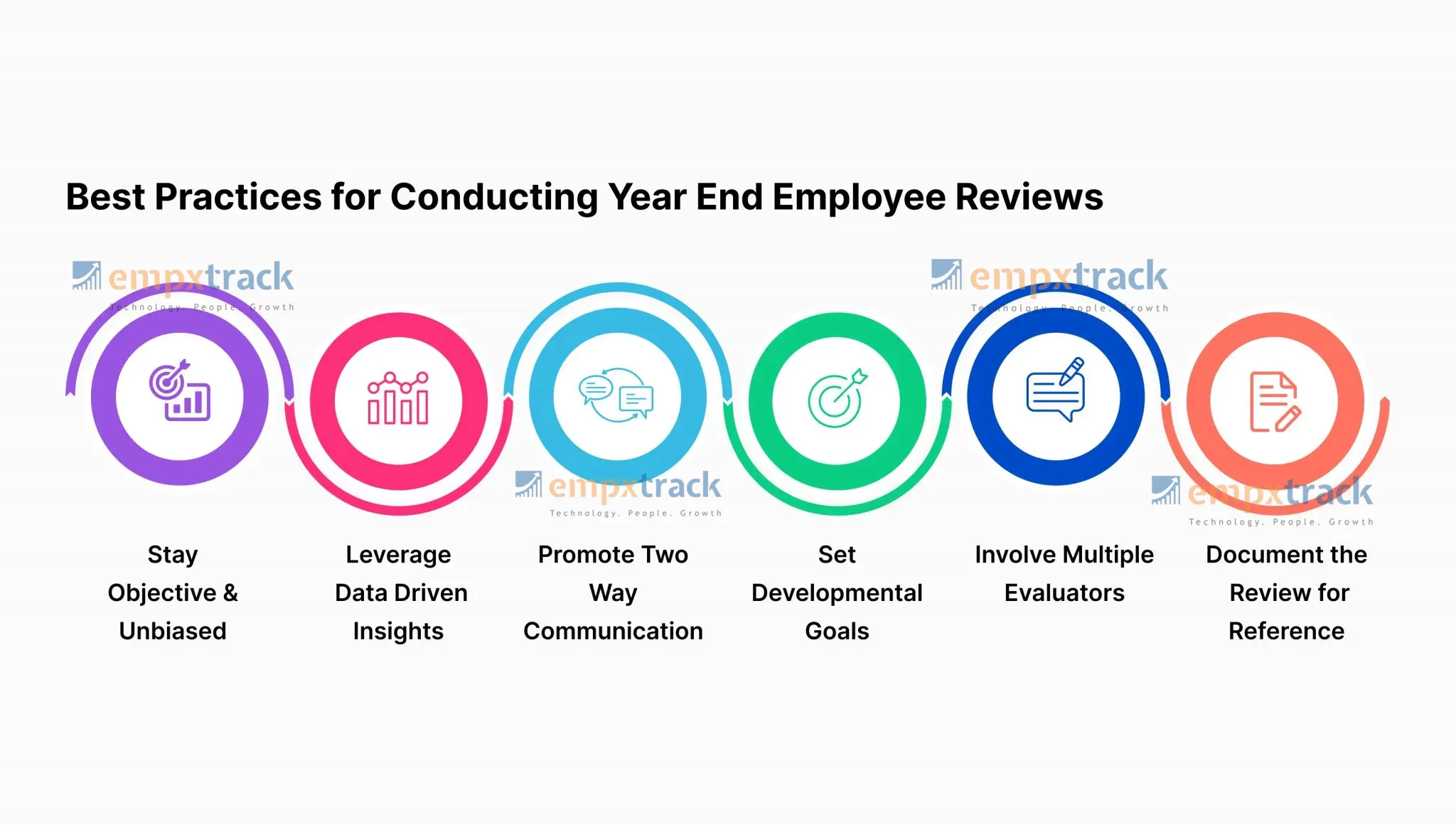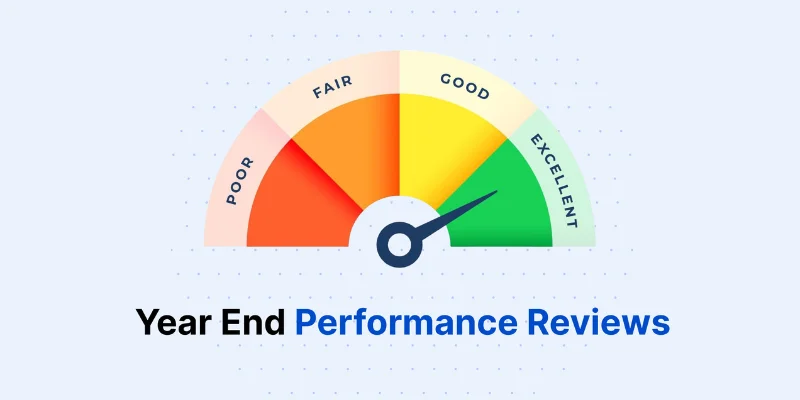The year-end review is more than just a routine—it’s a moment to pause and reflect. For many, it’s a chance to celebrate hard work, acknowledge challenges, and set a clear path forward.
As the calendar winds down, managers and employees come together to discuss accomplishments, uncover growth opportunities, and ensure individual contributions align with the bigger picture. Conducting a structured year end employee performance review therefore is a conversation that’s as much about the future as it is about the past, a time to listen, share, and plan for what’s next.
The year-end review can become a powerful tool for connection and progress; however, it requires a thoughtful approach. This annual evaluation provides a valuable opportunity for promoting growth, boosting engagement, and ensuring continuous improvement across the organization.
This guide explores the year end review process, key components, and best practices for making each review impactful and productive. In addition, it provides valuable insights to help ensure that every review contributes to employee growth and organizational success.
Table of Contents
- 1. What Are Year End Reviews?
- 2. Why Are Year End Reviews Important?
- 3. Preparing for the Year End Review Process
- 4. Conducting a Successful Year End Employee Review
- 5. Common Mistakes to Avoid in Year End Performance Reviews
- 6. Year End Review Examples for Managers and Employees
- 7. Best Practices for Conducting Year End Employee Reviews
- 8. Real World Case Study
- 9. How HR Solutions Simplify the Year End Review Process
- 10. Conclusion
- 11. Frequently Asked Questions
What Are Year End Reviews?
A year end review is also known as a year end employee review or end of the year performance review. This annual review is a structured process used by organizations to assess employee performance over the past year. Infact, conducting an annual review allows both managers and employees to evaluate accomplishments, discuss challenges, and set goals for the upcoming year.
Why Are Year End Reviews Important?
A year end performance review is much more than just a checklist task. It offers several key benefits that directly impact both employees and the organization:
Enhanced Employee Development
Managers provide targeted feedback that highlights specific strengths and areas for improvement. This approach not only supports continuous professional growth but also empowers employees to develop new skills over time.
Increased Engagement
Employee reviews foster open communication between employees and managers. By encouraging honest dialogue, these reviews thus boost employee engagement and contribute to a more satisfying work environment.
Alignment with Business Objectives
When organizations review employee performance, they ensure that individual contributions are in sync with company goals. This alignment further enhances productivity and ensures that each team member is moving in the same strategic direction.
Preparing for the Year End Review Process
Getting ready for the year-end review is where the real work begins. Here’s a step-by-step guide to help you prepare for effective year end performance reviews.
| Collect Comprehensive Data | Gather data year-round, including performance metrics, peer feedback, project outcomes, and customer input. This will ensure the accuracy and fairness of end of the year performance reviews. |
| Define Evaluation Metrics and Goal | Each review should focus on specific, measurable objectives. Moreover, it’s important to define clear metrics or criteria for the evaluation, as this helps managers assess performance fairly and consistently. |
| Encourage Self-Assessments | Encourage self-assessment to gain insights, and highlight employee’s perspective on accomplishments and areas for improvement. Furthermore, a self-assessment encourages engagement in year-end evaluation. |
| Set the Agenda | Plan the topics you’ll cover like performance highlights, growth areas, successes, and setting future goals. This will thus ensure a focused, productive meeting. |
Conducting a Successful Year End Employee Review
Almost 60% of millennial workers believe their managers are unprepared to give constructive feedback during their performance reviews.
The success of the year end employee review hinges on fostering open dialogue between managers and employees. To conduct a productive performance review, follow these steps:
Begin with Positive Feedback
Start by acknowledging the employee’s achievements. Recognizing accomplishments not only fosters a positive atmosphere but also helps employees feel appreciated. For example, you might say, “You played a key role in [specific project], which significantly impacted the team’s success.”

Deliver Constructive Feedback
Next, provide constructive criticism regarding areas for improvement, ensuring that you use specific examples. Instead of vague statements, rely on data and real instances. For instance, you might say, “On [project], we faced challenges in meeting deadlines. Let’s work together on time management strategies to enhance on-time delivery.”
Discuss Goals and Create a Performance Review Plan
Setting new goals and developing a performance review plan for the upcoming year is essential for continuous improvement. Furthermore, with a goal setting software, your managers and employees can set and track SMART employee goals aligned to business objectives.
Allow Room for Employee Feedback
Encourage employees to share their perspectives, concerns, and ideas. By allowing them to voice their thoughts, you create a more balanced year end evaluation that promotes open communication between the employees and the managers. This furthermore enhances engagement.
End with Encouragement and Next Steps
Finally, conclude the review with expressions of appreciation and outline the next steps. Highlight the employee’s potential and express your enthusiasm for their future contributions, thus motivating them for the year ahead.
Common Mistakes to Avoid in Year End Performance Reviews
While the year end review process can be highly beneficial, certain pitfalls can hinder its effectiveness. Here are some common mistakes to avoid:
Relying Solely on Recent Events
A common error is to focus only on recent events. Hence, to avoid this recency bias, review performance data from the entire year to get a complete picture.
Avoiding Difficult Conversations
Avoiding constructive feedback can diminish the impact of the review. Managers should approach challenging topics tactfully, focusing on growth opportunities rather than shortcomings.
Lack of Consistency
Inconsistent criteria across employee reviews can lead to unfair evaluations and dissatisfaction. Therefore, to maintain objectivity, use standard metrics and evaluation criteria for all employees during the annual review.
Not Following Up on Goals
Setting goals without follow-up can lead to stagnation. Managers should plan to check in on goal progress throughout the year. This will ultimately ensure that both the employee and manager are aligned.
Year End Review Examples for Managers and Employees
For Managers
| Positive Feedback | |
| Aptitude | “You consistently demonstrate exceptional skills in your role, which contributes significantly to our success.” |
| Attendance | “Your attendance is outstanding. It clearly reflects your dedication to the team.” |
| Communication | “You communicate clearly. This helps keep everyone informed and engaged.” |
| Dependability | “I can always rely on you. You consistently deliver your work on time.” |
| Creativity | “Your innovative ideas significantly benefit our projects and inspire the team.” |
| Constructive Feedback | |
| Attendance | “Your attendance is generally good. However, I encourage you to reduce any unplanned absences.” |
| Time Management | “I’ve noticed meeting deadlines has been challenging for you. Let’s work on improving your time management skills.” |
| Collaboration | “I would like to see you engage more with your team members. This will in turn improve overall collaboration.” |
| Quality of Work | “Some of your recent work did not meet our quality standards. Let’s identify ways to improve this.” |
For Employees
| Positive Feedback | |
| Aptitude | “The confidence you show in your skills contributes effectively to the team’s goals.” |
| Attendance | “Maintaining a strong attendance record shows your commitment to the team.” |
| Communication | “Your clear communication ensures that everyone stays aligned and informed.” |
| Dependability | “Your reliability is commendable. You consistently meet deadlines.” |
| Creativity | “Your creative solutions enhance our projects and lead to better outcomes.” |
| Constructive Feedback | |
| Time Management | “There is an opportunity to improve time management skills. This will definitely help in meeting deadlines more consistently.” |
| Attendance | “Improving attendance is important for overall team success.” |
| Collaboration | “Engaging more with colleagues will strengthen team dynamics.” |
| Quality of Work | “Enhancing the quality of work is essential. Therefore, seeking feedback regularly can help achieve this.” |
Best Practices for Conducting Year End Employee Reviews
To maximize the effectiveness, follow these best practices:

Stay Objective and Unbiased
Use objective data and standard performance criteria. This approach reduces unconscious bias and ensures fairness in your year end evaluations.
Leverage Data-Driven Insights
Utilize performance data to support your feedback. For example, refer to project outcomes, sales figures, or customer satisfaction scores. By using data-driven insights, you make your feedback more credible and actionable.
Promote Two-Way Communication
Engage employees by encouraging their feedback, ideas, and perspectives. Furthermore, a collaborative year end performance review fosters trust and open communication.
Set Developmental Goals
Focus on growth opportunities during your annual reviews. Instead of merely assessing past performance, you should set actionable goals for the future.
Involve Multiple Evaluators
Include multiple evaluators to gather diverse perspectives. A 360 degree feedback tool can be helpful as it solicits anonymous feedback from various sources- employee’s manager, peers, subordinates, direct reports, and external reviewers. This will in turn help reduce individual biases and help your employees develop and grow.
Document the Review for Reference
Ensure you document each review. This documentation tracks progress and serves as a guide for subsequent annual performance evaluations.
Real World Case Study
Understanding the impact of a structured year end performance review becomes clearer when looking at a real world example of Busch LLC. It is one of the US’s largest manufacturers of vacuum pumps, blowers and low pressure technology products with a workforce of more than 500 employees.
After implementing Empxtrack performance management software, the company streamlined goal setting, automated competency mapping, and gained real-time visibility into employee progress. The other noteworthy benefits were:
- Performance appraisals became more transparent, holistic, and meaningful
- Managers could track goal progress and achievement updates anytime
- Employee development needs could be easily identified
- Employees felt empowered to take their own career decisions
- Easy data integration with ADP eliminated the data errors
- CPM improved productivity and training outcomes
- Strengthened talent management and culture improvement
👉 Read the full case study here. Book a quick demo to explore how the system can support your year end reviews and simplify your HR workflows.
How HR Solutions Simplify the Year End Review Process
HR performance management tools streamline the review process by automating many administrative tasks. This automation allows HR teams to focus on meaningful conversations and enables managers to concentrate on employee growth and development.
Only 45% of organizational leaders believe that their organization uses consistent tools to monitor and review employee performance.
By automating performance evaluations, HR tools like Empxtrack performance management solution, enable managers to easily access employee data, feedback, and performance metrics in one centralized location. As a result, they can quickly generate comprehensive reviews without the hassle of sifting through paperwork or relying on outdated methods. This efficiency not only saves time but also ensures that evaluations are based on accurate and up-to-date information.
Furthermore, Empxtrack enhances collaboration among evaluators by allowing for real-time feedback and input from multiple sources. Employees can engage with the platform to share their self-assessments and goals, fostering a two-way communication channel. Consequently, managers receive a well-rounded view of employee performance, making it easier to identify strengths and areas for improvement.
Overall, implementing Empxtrack performance management solution simplifies the year-end review process, leading to more meaningful evaluations and better alignment with organizational goals.
Conclusion
A well-structured end of the year review is essential for fostering employee growth, aligning efforts with organizational goals, and boosting overall productivity. By focusing on constructive feedback, data-driven insights, and open communication, managers can transform the year-end employee review into a powerful tool for continuous improvement.
Empxtrack’s performance management software provides the resources necessary to make this process efficient, objective, and beneficial for both employees and organizations alike. Embrace the power of a thorough year end review to enhance employee performance and achieve your company’s goals.
Liked what you read? Let’s take it to the next level!
Frequently Asked Questions
Q1. | What is the purpose of a year end review? |
| Ans. | A year-end review aims to assess an employee’s performance over the past year. It further provides feedback on achievements and areas for improvement, and set goals for the coming year. Moreover, it aligns individual performance with organizational objectives and fosters personal growth. |
Q2. | How does a year end review differ from regular feedback? |
| Ans. | Regular feedback is typically informal and ongoing, focusing on specific tasks or projects. In contrast, a year-end review is a comprehensive performance evaluation that provides a holistic overview of an employee’s contributions and achievements over the entire year. |
Q3. | What should a manager prepare before the end of the year review? |
| Ans. | Before conducting a year-end review, a manager should collect relevant data (such as performance metrics, project outcomes, and peer feedback). They should also define evaluation criteria, prepare a structured agenda, and also encourage the employee to complete a self-assessment. |
Q4. | What are common mistakes to avoid in a year end review? |
| Ans. | Common mistakes include focusing only on recent events, avoiding difficult conversations, being inconsistent in evaluations, as well as failing to set follow-up plans for established goals. These can subsequently reduce the effectiveness of the review process. |
Q5. | What goals should be discussed in the review? |
| Ans. | Goals for the year-end review should focus on both professional development (such as skills enhancement or project leadership) and also performance outcomes (such as meeting sales targets or improving customer satisfaction). Moreover, these goals should align with the organization’s broader objectives. |
Q6. | What is an example of a year end review? |
| Ans. | A year-end review example could involve recognizing an employee’s success in completing a challenging project. Additionally, the discussion might cover areas for improvement, such as time management. Finally, the review would conclude by setting new goals for the upcoming year, like leading a team project or developing specific skills. |
Q7. | How can managers avoid biases in end of the year reviews? |
| Ans. | Managers can reduce biases by using objective data and standard performance metrics. They can additionally use input from multiple sources, such as 360-degree feedback. Consistent evaluation criteria across employees also help in minimizing bias. |




Excellent article! We will be linking to this particularly great article on our site.
Keep up the great writing.
Such a well-structured guide! The emphasis on open communication and two-way feedback really stood out. It’s refreshing to see a performance review approach that prioritizes employee growth rather than just evaluation.
Thank you for sharing this insightful blog. Your analysis is both thorough and engaging, effectively conveying complex ideas with clarity and precision. I appreciate the depth of research and the valuable perspectives you provided. This is a commendable contribution to the discourse. I look forward to reading more of your work
Thanks a lot. Glad you found it valuable!